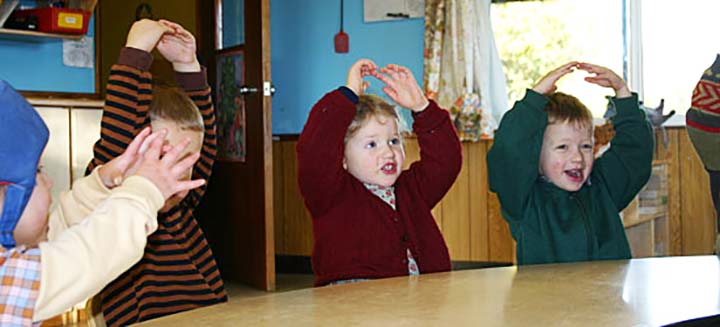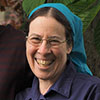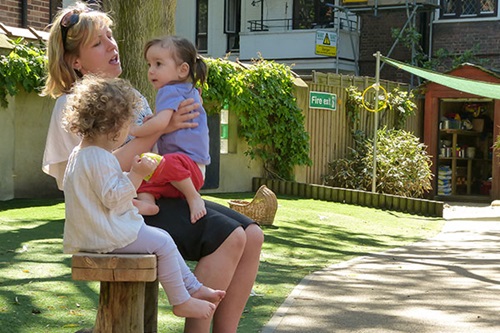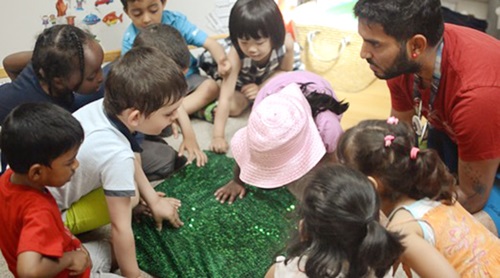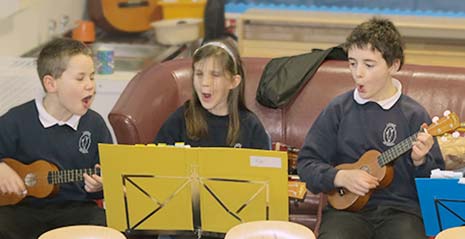Circle time activities
Songs, rhymes and singing games for babies and toddlers
| June 2012Babies absorb life through all their senses, including of course their sense of hearing. As a caregiver in various centres and with my own six children, I experienced the benefits of singing with children under three years of age. Lullabies are probably the oldest form of song and can be found in every culture. I heard an Indonesian lullaby, ‘Suliram,’ that was so beautiful it brought tears to my eyes, even though I could not understand the words. Indeed, lullabies’ lyrics - like those of nursery rhymes - are often nonsense, since they are not intended for adult ears at all. (‘When you wake you will have cake, and all the pretty little horses…’) Music is a language in itself, and I am convinced it is a language the youngest children understand. Even a newborn baby can be soothed by song, and a baby’s repeated hearing of his mother’s voice crooning and singing is part of the bonding process. When a mother sings or chants to the baby in her arms, he not only hears her voice with his ears, but his whole body receives her rhythm.
During earliest infancy, songs are usually intended to lull a baby to sleep. But parents sing or chant while they play with their babies too; older babies are dandled on dad or mum’s knee to a nursery rhyme or tune: ‘Pat-a-cake, pat-a-cake baker’s man,’ ‘Ride a cock horse to Banbury Cross.’ They love the rhythm, clapping, tickling, and bouncing that go with these jingles, such as ‘Trot, trot to market to buy a pound of butter, Trot, trot home again, Drop her in the gutter!’ Other ditties accompany bathing time, dressing time (‘This little piggy went to market’), or washing up after meals (‘This is the way we wash our face…’).
Singing with babies
As I worked with babies and one-year-olds, I realised I was singing nearly all the time about the activities we did together or the things we saw. It came naturally, and as babies are not critical listeners, I did not feel self-conscious. Some were simple songs I’d grown up with; others I invented on the spur of the moment. There are songs about rain, about flowers, about bugs; there are songs to help us wake up and others to help us sleep; there are songs for festivals, and songs to bolster us in potentially fearful situations – like when we meet a big dog or witness a thunderstorm.
I was surprised at what an early age the babies began to join the singing. Most joined songs they recognised with a loud ‘ahhh…’ sound when they were between 10 and 12 months old. They caught and enjoyed the rhythm, sometimes swaying to the beat. At around 20 months, many children started filling in the last word of each phrase. Jennifer, nearly two, did not talk at all - but she ‘sang’ on perfect pitch and had a large repertoire!
Singing offers children a form of expression for their thoughts and feelings. As a family, we have always sung with our children at bedtime. One evening our 2 ½-year-old was singing so loudly that I was about to remonstrate, when he said with satisfaction, ‘The angels heard that!’
Finger-games and with toddlers
Similarly, young children love finger games. These are perfect for circle time with under-3s. Children of this age spend most of their waking hours involved in individual exploratory play, but they have a social impulse too and enjoy gathered times on the floor or around a low table with their carer. I am sometimes surprised how seriously children take the lyrics. Once during a favourite finger game –
Up the tall white candlestick goes little Mousie Brown,
Right to the top, but he couldn’t get down.
So he called to his grandma,
‘Grandma! Grandma!’
But grandma was in town.
So he curled himself into a ball
And ro-o-o-lled down.
– one child’s chin began to quiver as she called ‘Grandma! Grandma!’ feeling Mousie’s distress quite personally!
Exploring sounds and language
Two- and three-year-olds have an impulse to experiment with words. This is sometimes labelled ‘silliness,’ when they create nonsense words (iggy-giggy, etc). But we adults need to understand that this urge represents an important phase in language development, and help provide outlets for it. Rhythmic poetry offers one such outlet. I have had whole groups of twos and threes joining the refrain on
What does the train say, jiggle joggle, jiggle joggle,
What does the train say, jiggle joggle jee?
Will the little baby go riding with the locomo?
Lokey mokey pokey stokey smokey chokey chee!
(This is just the first stanza of a long poem. The last line begins very quietly and builds to a climax on ‘Chee!’)
Involve the whole body into your circle games
Finger games and poems evolve into circle games involving the whole body, like ‘I’m a little teapot short and stout’ or ‘Ring a ring o’ roses.’ Nigerian friends introduced me to singing games from their culture, which I used in the centre as well. Singing and chanting games with large-motor action are a lot of fun and support children’s sense of rhythm. There are good collections of songs, circle games, nursery rhymes and finger games to be had, as well as the ones you learn by ‘word of mouth.’ Circle time can strengthen friendship among the children, as well as fine-tuning their audio skills. Since circle time is intense and takes concentration, carers need to be sensitive to children’s responses. It’s better to wind down if you feel the children getting restless, and let them return to unstructured play. We want children to anticipate circle time with pleasure!

